Impact of Extreme Droughts on the Water Balance in the Peruvian–Ecuadorian Amazon Basin (2003–2024)
Abstract
1. Introduction
2. Data and Methods
2.1. Study Area
2.2. Data Sources of Different Components of the Water Balance
2.3. Methodologies
2.3.1. Drought Events
2.3.2. Matching Coefficients
2.3.3. Water Balances
2.3.4. Drought Indices
3. Results
3.1. Precipitation
3.2. Intercomparison of Evapotranspiration Datasets
3.3. Drought Indices
3.4. Average Monthly Cycles and Annual Variation of Components for Water Balance
3.5. Uncertainty Analysis
4. Discussion and Conclusions
Supplementary Materials
Author Contributions
Funding
Data Availability Statement
Acknowledgments
Conflicts of Interest
References
- Saatchi, S.S.; Harris, N.L.; Brown, S.; Lefsky, M.; Mitchard, E.T.A.; Salas, W.; Zutta, B.R.; Buermann, S.W.; Lewis, L.; Hagen, S.; et al. Benchmark map of forest carbon stocks in tropical regions across three continents. Proc. Natl. Acad. Sci. USA 2011, 108, 9899–9904. [Google Scholar] [CrossRef] [PubMed]
- Costa, M.H.; Borma, L.S.; Espinoza, J.-C.; Macedo, M.; Marengo, J.A.; Marra, D.M.; Ometto, J.P.; Gatti, L.V. Chapter 5: The physical hydroclimate system of the Amazon, 2021. In Amazon Assessment Report 2021; Nobre, C., Encalada, A., Anderson, E., Roca Alcazar, F.H., Bustamante, M., Mena, C., Peña-Claros, M., Poveda, G., Rodriguez, J.P., Saleska, S., et al., Eds.; United Nations Sustainable Development Solutions Network: New York, NY, USA, 2021; Available online: https://www.theamazonwewant.org/spa-reports/ (accessed on 27 May 2025).
- Builes-Jaramillo, A.; Poveda, G. Conjoint analysis of surface; atmospheric water balances in the Andes-Amazon system. Water Resour. Res. 2018, 54, 3472–3489. [Google Scholar] [CrossRef]
- Armijos, E.; Crave, A.; Espinoza, J.-C.; Filizola, N.; Espinoza-Villar, R.; Fonseca, P. Rainfall control on Amazon sediment flux: Synthesis from 20 years of monitoring. Environ. Res. Commun. 2020, 2, 051008. [Google Scholar] [CrossRef]
- Beveridge, C.F.; Espinoza, J.C.; Athayde, S.; Correa, S.B.; Couto, T.B.; Heilpern, S.A.; Jenkins, C.N.; Piland, N.C.; Utsunomiya, R.; Wongchuig, S.; et al. The Andes-Amazon-Atlantic pathway: A foundational hydroclimate system for social-ecological system sustainability. Proc. Natl. Acad. Sci. USA 2024, 121, e2306229121. [Google Scholar] [CrossRef]
- Healy, R.W.; Winter, T.C.; LaBaugh, J.W.; Franke, O.L. Water Budgets: Foundations for Effective Water Resources; Environmental Management; U.S. Geological Survey Circular: Reston, VA, USA, 2007; p. 1308.
- Espinoza, J.-C.; Ronchail, J.; Guyot, J.L.; Cochonneau, G.; Naziano, F.; Lavado, W.; De Oliveira, E.; Pombosa, R.; Vauchel, P. Spatio-temporal rainfall variability in the Amazon basin countries (Brazil; Peru; Bolivia; Colombia,; Ecuador). Int. J. Climatol. 2009, 29, 1574–1594. [Google Scholar] [CrossRef]
- Zanin, P.R.; Pareja-Quispe, D.; Espinoza, J.-C. Evapotranspiration in the Amazon Basin; Couplings, hydrological memory; water feedback. Agric. Forest Meteorol. 2024, 352, 110040. [Google Scholar] [CrossRef]
- Espinoza Villar, J.-C.; Guyot, J.L.; Ronchail, J.; Cochonneau, G.; Filizola, N.; Fraizy, P.; Labat, D.; de Oliveira, E.; Ordoñez, J.J.; Vauchel, P. Contrasting regional discharge evolutions in the Amazon basin (1974–2004). J. Hydrol. 2009, 375, 297–311. [Google Scholar] [CrossRef]
- Kimball, B.A.; Bernacchi, C.J. Evapotranspiration, Canopy Temperature; Plant Water Relations. In Managed Ecosystems; CO2. Ecological Studies; Nösberger, J., Long, S.P., Norby, R.J., Stitt, M., Hendrey, G.R., Blum, H., Eds.; Springer: Berlin/Heidelberg, Germany, 2006; Volume 187. [Google Scholar] [CrossRef]
- Drumond, A.; Marengo, J.; Ambrizzi, T.; Nieto, R.; Moreira, L.; Gimeno, L. The role of the Amazon Basin moisture in the atmospheric branch of the hydrological cycle: A Lagrangian analysis. Hydrol. Earth Syst. Sci. 2014, 18, 2577–2598. [Google Scholar] [CrossRef]
- Wongchuig, S.; Espinoza, J.-C.; Condom, T.; Junquas, C.; Sierra, J.P.; Fita, L.; Sörensson, A.; Polcher, J. Changes in the surface; atmospheric water budget due to projected Amazon deforestation: Lessons from a fully coupled model simulation. J. Hydrol. 2023, 625, 130082. [Google Scholar] [CrossRef]
- Sierra, J.P.; Espinoza, J.-C.; Junquas, C.; Wongchuig, S.; Polcher, J.; Moron, V.; Fita, L.; Arias, P.A.; Schrapffer, A.; Pennell, R. Impacts of land-surface heterogeneities; Amazonian deforestation on the wet season onset in southern Amazon. Clim. Dyn. 2023, 61, 4867–4898. [Google Scholar] [CrossRef]
- Davidson, E.A.; de Araújo, A.C.; Artaxo, P.; Balch, J.K.; Brown, I.F.; Bustamante, M.M.C.; Coe, M.T.; DeFries, R.S.; Keller, M.; Longo, M.; et al. The Amazon basin in transition. Nature 2012, 481, 321–328. [Google Scholar] [CrossRef]
- Espinoza, J.-C.; Ronchail, J.; Guyot, J.L.; Junquas, C.; Vauchel, P.; Lavado, W.S.; Drapeau, G.; Pombosa, R. Climate variability; extremes drought in the upper Solimões River (Western Amazon Basin): Understanding the exceptional 2010 drought. Geophys. Res. Lett. 2011, 38, L13406. [Google Scholar] [CrossRef]
- Espinoza, J.-C.; Jimenez, J.C.; Marengo, J.A.; Schongart, J.; Ronchail, J.; Lavado-Casimiro, W.; Ribeiro, J.M. The new record of drought; warmth in the Amazon in 2023 related to regional; global climatic features. Sci. Rep. 2024, 14, 8107. [Google Scholar] [CrossRef]
- Marengo, J.; Cunha, A.; Espinoza, J.-C.; Fu, R.; Schöngart, J.; Jimenez, J.; Costa, M.; Ribeiro, J.; Wongchuig, S.; Zhao, S. The Drought of Amazonia in 2023–2024. Am. J. Clim. Change 2024, 13, 567–597. [Google Scholar] [CrossRef]
- Marengo, J.A.; Espinoza, J.C. Extreme Seasonal Droughts; Floods in Amazonia; Causes, Trends; Impacts. Int. J. Climatol. 2016, 36, 1033–1055. [Google Scholar] [CrossRef]
- Jiménez-Muñoz, J.; Mattar, C.; Barichivich, J.; Santamaría-Artigas, A.; Takahashi, K.; Malhi, Y.; Sobrino, J.A.; van der Schrier, G. Record-breaking warming; extreme drought in the Amazon rainforest during the course of El Niño 2015–2016. Sci. Rep. 2016, 6, 33130. [Google Scholar] [CrossRef]
- Aragão, L.E.O.C.; Malhi, Y.; Roman-Cuesta, R.M.; Saatchi, S.; Anderson, L.O.; Shimabukuro, Y.E. Spatial Patterns; fire response of recent Amazonian droughts. Geophys. Res. Lett. 2007, 34, L07701. [Google Scholar] [CrossRef]
- Malhi, Y.; Aragao, L.E.O.C.; Galbraith, D.; Huntingford, C.; Fisher, R.; Zelazowski, P.; Sitch, S.; McSweeney, C.; Meir, P. Exploring the likelihood; mechanism of a climate-change-induced dieback of the Amazon forest. Proc. Natl. Acad. Sci. USA 2009, 106, 20610–20615. [Google Scholar] [CrossRef] [PubMed]
- Gatti, L.V.; Basso, L.S.; Miller, J.B.; Gloor, M.; Gatti-Domingues, L.; Cassol, H.L.G.; Tejada, G.; Aragão, L.E.C.; Nobre, C.; Peters, W.; et al. Amazonia as a carbon source linked to deforestation; climate change. Nature 2021, 595, 388–393. [Google Scholar] [CrossRef]
- Jimenez, J.-C.; Marengo, J.A.; Alves, L.M.; Sulca, J.C.; Takahashi, K.; Ferrett, S.; Collins, M. The role of ENSO flavours; TNA on recent droughts over Amazon forests; the Northeast Brazil region. Int. J. Climatol. 2019, 41, 3761–3780. [Google Scholar] [CrossRef]
- Doblas-Reyes, F.J.; Sorensson, A.A.; Almazroui, M.; Dosio, A.; Gutowski, W.J.; Haarsma, R.; Hamdi, R.; Hewitson, B.; Kwon, W.-T.; Lamptey, B.L.; et al. Linking global to regional climate change. In Climate Change 2021: The Physical Science Basis, Contribution of Working Group I to the Sixth Assessment Report of the Intergovernmental Panel on Climate Change; Masson-Delmotte, V., Zhai, P., Pirani, A., Connors, S.L., Pean, C., Berger, S., Caud, N., Chen, Y., Goldfarb, L., Gomis, M.I., et al., Eds.; Cambridge University Press: Cambridge, UK; New York, NY, USA, 2021; pp. 1363–1512. [Google Scholar] [CrossRef]
- Papastefanou, P.; Zang, C.S.; Angelov, Z.; de Castro, A.A.; Jimenez, J.C.; De Rezende, L.F.C.; Ruscica, R.C.; Sakschewski, B.; Sörensson, A.A.; Thonicke, K.; et al. Recent extreme drought events in the Amazon rainforest: Assessment of different precipitation; evapotranspiration datasets; drought indicators. Biogeosciences 2022, 19, 3843–3861. [Google Scholar] [CrossRef]
- Mamani, L.; Andreoli, R.V.; Parente de Souza, I.; Cevalho, W.; Sales, D.; Kayano, M.T.; de Souza, R.A.F.; Molina-Carpio, J.; Ceron, W.L.; Macedo, T. Extreme droughts in the Amazon Basin during cyclic ENSO events coupled with Indian Ocean Dipole modes; Tropical North Atlantic warming. Sci. Total Environ. 2025, 963, 178536. [Google Scholar] [CrossRef]
- Martínez-Castro, D.; Takahashi, K.; Espinoza, J.-C.; Vichot-Llano, A.; Andrade, M.O.; Silva, F.Y. Extreme droughts in the Peruvian Amazon region (2000–2024). Water 2025, 17, 744. [Google Scholar] [CrossRef]
- Funk, C.; Peterson, P.; Landsfeld, M.; Pedreros, D.; Verdin, J.; Shukla, S.; Husak, G.; Rowland, J.; Harrison, L.; Hoell, A.; et al. The climate hazards infrared precipitation with stations—A new environmental record for monitoring extremes. Sci. Data 2015, 2, 1–21. [Google Scholar] [CrossRef] [PubMed]
- Beck, H.E.; Wood, E.F.; Pan, M.; Fisher, C.K.; Miralles, D.G.; van Dijk, A.I.J.M.; McVicar, T.R.; Adler, R.F. MSWEP V2 Global 3-Hourly 0.1° Precipitation: Methodology; Quantitative Assessment. Bull. Am. Meteor. Soc. 2019, 100, 473–500. [Google Scholar] [CrossRef]
- Hersbach, H.; Bell, B.; Berrisford, P.; Hirahara, S.; Horányi, A.; Muñoz-Sabater, J.; Nicolas, J.; Peubey, C.; Radu, R.; Schepers, D.; et al. The ERA5 global reanalysis. Q. J. R. Meteorol. Soc. 2020, 146, 1999–2049. [Google Scholar] [CrossRef]
- Rodell, M.; Houser, P.R.; Jambor, U.; Gottschalck, J.; Mitchell, K.; Meng, C.-J.; Arsenault, K.; Cosgrove, B.; Radakovich, J.; Bosilovich, M.; et al. The Global Land Data Assimilation System. Bull. Am. Meteorol. Soc. 2004, 85, 381–394. [Google Scholar] [CrossRef]
- da Motta Paca, V.H.; Espinoza-Dávalos, G.E.; Hessels, T.M.; Medeiros Moreira, D.; Comair, G.F.; Bastiaanssen, W.G.M. The spatial variability of actual evapotranspiration across the Amazon River Basin based on remote sensing products validated with flux towers. Ecol. Process. 2019, 8, 6. [Google Scholar] [CrossRef]
- Save, H.; Bettadpur, S.; Tapley, B.D. High-Resolution CSR GRACE RL05 Mascons. J. Geophys. Res. Solid Earth 2016, 121, 7547–7569. [Google Scholar] [CrossRef]
- Tapley, B.D.; Bettadpur, S.; Ries, J.C.; Thompson, P.F.; Watkins, M.M. GRACE Measurements of Mass Variability in the Earth System. Science 2004, 305, 503–505. [Google Scholar] [CrossRef] [PubMed]
- Li, B.; Rodell, M.; Kumar, S.; Beaudoing, H.; Getirana, A.; Zaitchik, B.F.; de Goncalves, L.G.; Cossetin, C.; Bhanja, S.; Mukherjee, A.; et al. Global GRACE data assimilation for groundwater; drought monitoring: Advances; challenges. Water Resour. Res. 2019, 55, 7564–7586. [Google Scholar] [CrossRef]
- Landerer, F.W.; Flechtner, F.M.; Save, H.; Webb, F.H.; Bandikova, T.; Bertiger, W.I.; Bettadpur, S.V.; Byun, S.H.; Dahle, C.; Dobslaw, H.; et al. Extending the global mass change data record: GRACE Follow On instrument; science data performance. Geophys. Res. Lett. 2020, 47, e2020GL088306. [Google Scholar] [CrossRef]
- Kling, H.; Fuchs, M.; Paulin, M. Runoff conditions in the upper Danube basin under an ensemble of climate change scenarios. J. Hydrol. 2012, 424–425, 264–277. [Google Scholar] [CrossRef]
- Zeng, N. Seasonal cycle; interannual variability in the Amazon hydrologic cycle. J. Geophys. Res. 1999, 104, 9097–9106. [Google Scholar] [CrossRef]
- Balsamo, G.; Viterbo, P.; Beljaars, A.; van den Hurk, B.; Hirschi, M.; Betts, A.K.; Scipal, K. A revised hydrology for the ECMWF model: Verification from field site to terrestrial water storage; impact in the Integrated Forecast System. J. Hydrometeorol. 2009, 10, 623–643. [Google Scholar] [CrossRef]
- Marengo, J.A. Characteristics; spatio-temporal variability of the Amazon River Basin Water Budget. Clim. Dyn. 2004, 24, 11–22. [Google Scholar] [CrossRef]
- Vicente-Serrano, S.M.; Beguería, S.; Lorenzo-Lacruz, J.; Camarero, J.J.; López-Moreno, J.I.; Azorin-Molina, C.; Revuelto, J.; Morán-Tejeda, E.; Sanchez-Lorenzo, A. Performance of Drought Indices for Ecological; Agricultural; Hydrological Applications. Earth Interact. 2012, 16, 1–27. [Google Scholar] [CrossRef]
- Wells, N.; Goddard, S.; Hayes, M.J. A Self-Calibrating Palmer Drought Severity Index. J. Clim. 2004, 17, 2335–2351. [Google Scholar] [CrossRef]
- Paredes-Trejo, F.; Barbosa, H.; Giovannettone, J.; Lakshmi Kumar, T.V.; Kumar Takur, M.; de Oliveira Buriti, C. Drought variability; land degradation in the Amazon River basin. Front. Earth Sci. Sec. Environ. Inform. Remote Sens. 2022, 10, 1344. [Google Scholar] [CrossRef]
- Herrera, D.A.; Ault, T. Insights from a New High-Resolution Drought Atlas for the Caribbean Spanning 1950–2016. J. Clim. 2017, 30, 7801–7825. [Google Scholar] [CrossRef]
- Lewis, S.L.; Brando, P.M.; Phillips, O.L.; van der Heijden, G.M.F.; Nepsta, D. The 2010 Amazon Drought. Science 2011, 331, 554. [Google Scholar] [CrossRef]
- Zang, C.S.; Buras, A.; Esquivel-Muelbert, A.; Jump, A.S.; Rigling, A.; Rammig, A. Standardized drought indices in ecological research: Why one size does not fit all. Glob. Change Biol. 2020, 26, 322–324. [Google Scholar] [CrossRef] [PubMed]
- Hu, X.; Yuan, W. Evaluation of ERA5 precipitation over the eastern periphery of the Tibetan plateau from the perspective of regional rainfall events. Int. J. Climatol. 2021, 41, 2625–2637. [Google Scholar] [CrossRef]
- Ou, T.; Chen, D.; Tang, J.; Lin, C.; Wang, X.; Kukulies, J.; Lai, H. Wet bias of summer precipitation in the northwestern Tibetan Plateau in ERA5 is linked to overestimated lower-level southerly wind over the plateau. Clim. Dyn. 2023, 61, 2139–2153. [Google Scholar] [CrossRef]
- Espinoza, J.-C.; Arias, P.A.; Moron, V.; Junquas, C.; Segura, H.; Sierra-Pérez, J.P.; Wongchuig, S.; Condom, T. Recent Changes in the Atmospheric Circulation Patterns during the Dry-to-Wet Transition Season in South Tropical South America (1979–2020): Impacts on Precipitation; Fire Season. J. Clim. 2021, 34, 9025–9042. [Google Scholar] [CrossRef]
- Wongchuig, S.; Espinoza, J.C.; Condom, T.; Segura, H.; Ronchail, J.; Arias, P.A.; Junquas, C.; Rabatel, A.; Lebel, T. A regional view of the linkages between hydro-climatic changes; deforestation in the Southern Amazon. Int. J. Climatol. 2022, 42, 3757–3775. [Google Scholar] [CrossRef]
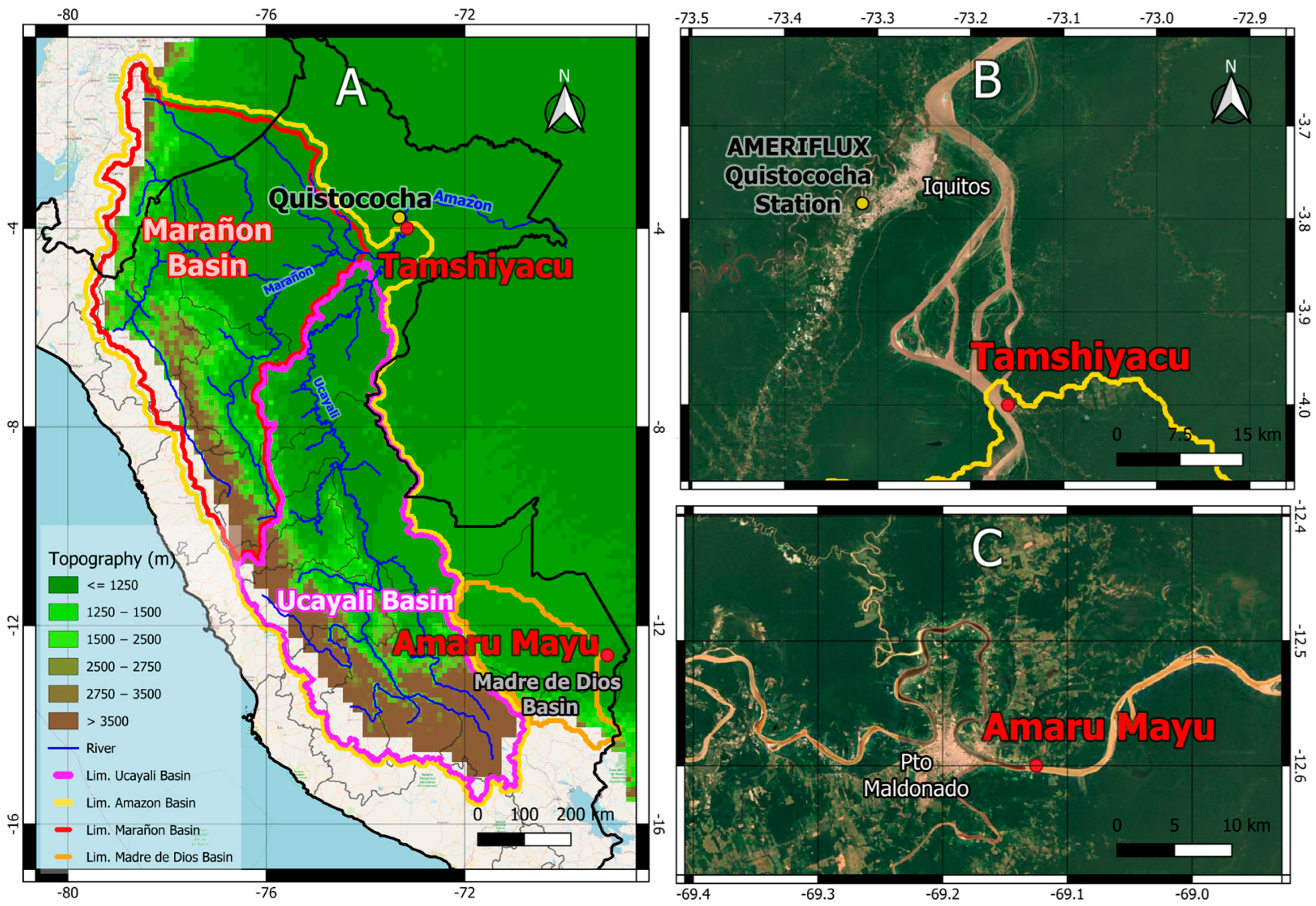
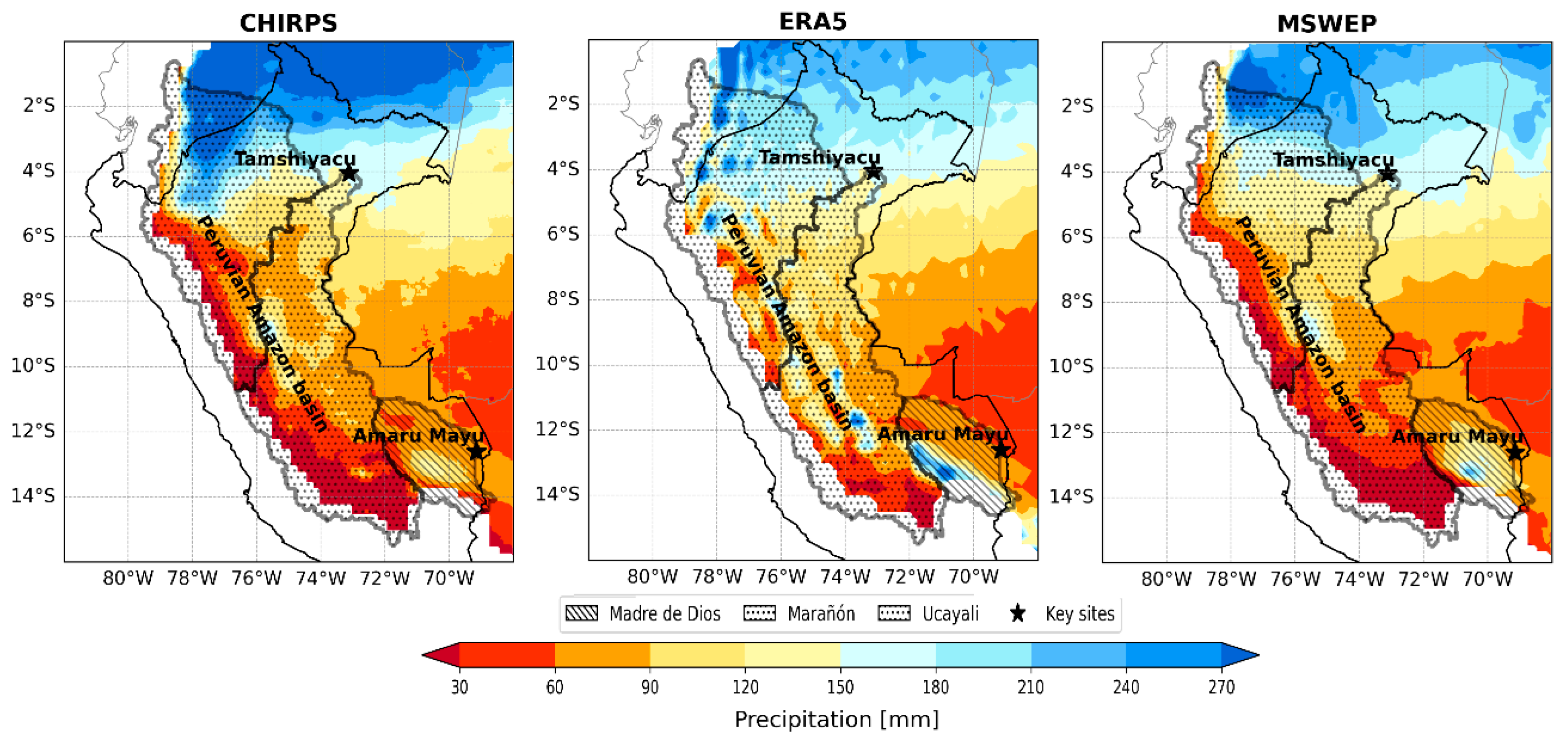



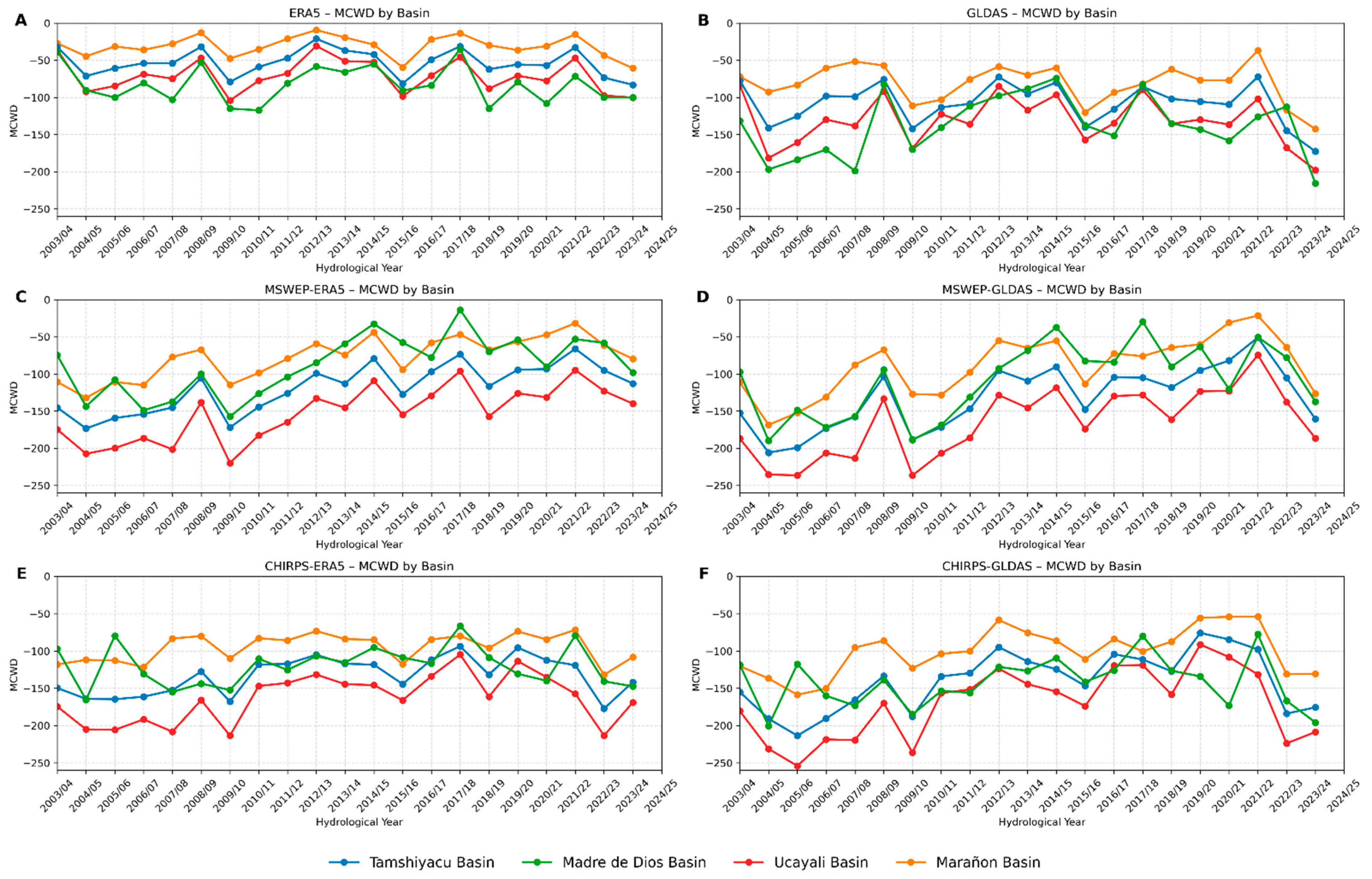
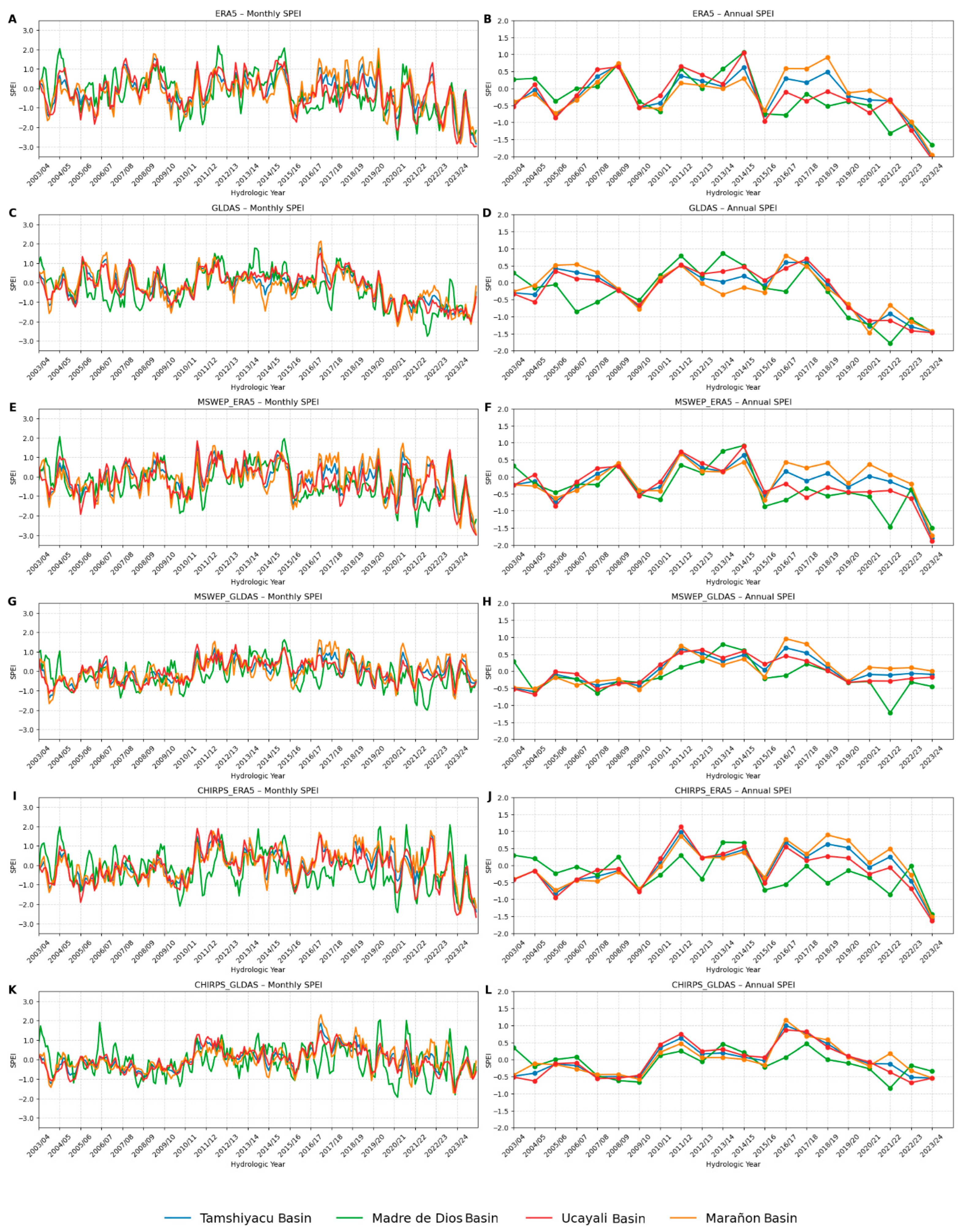


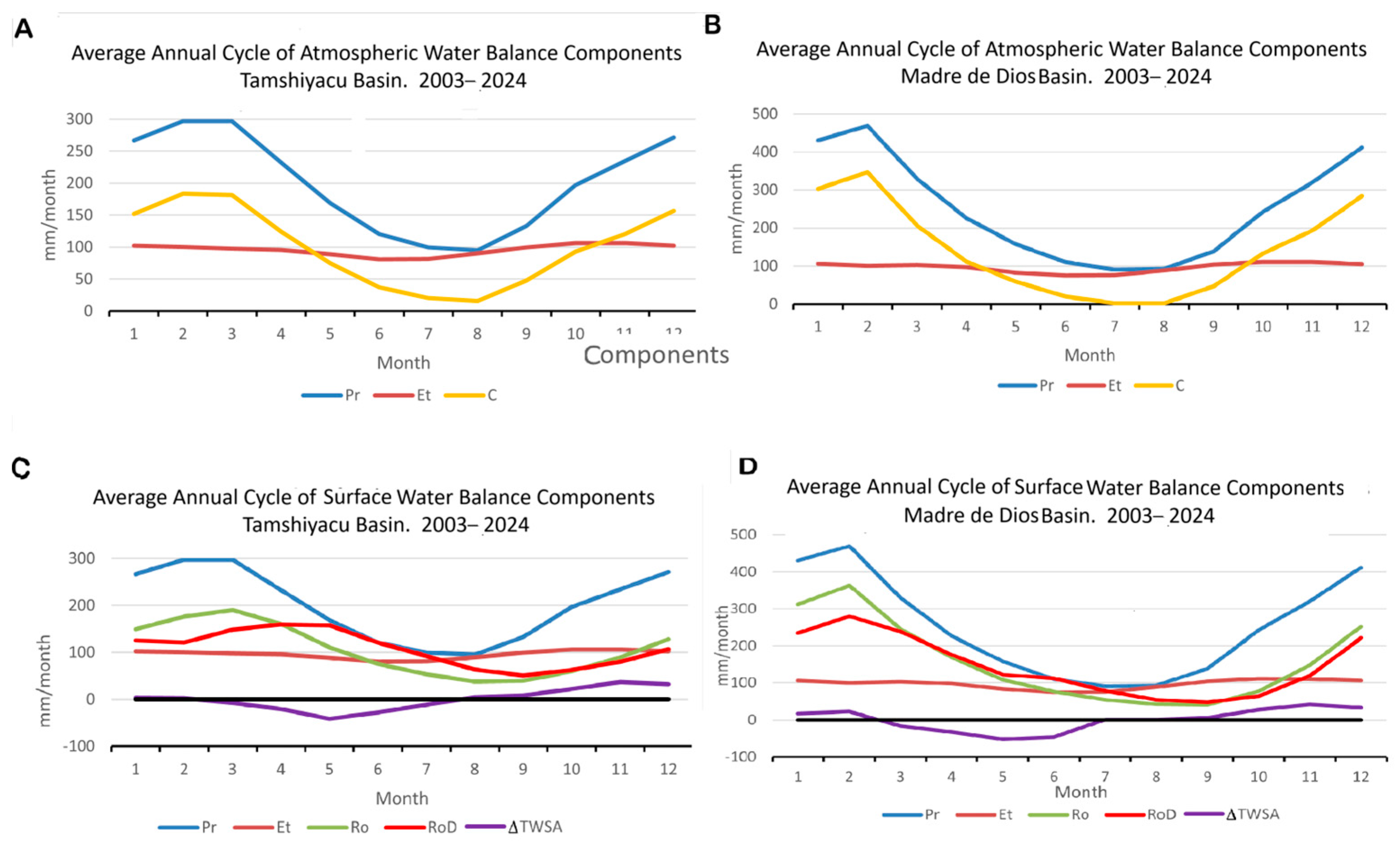
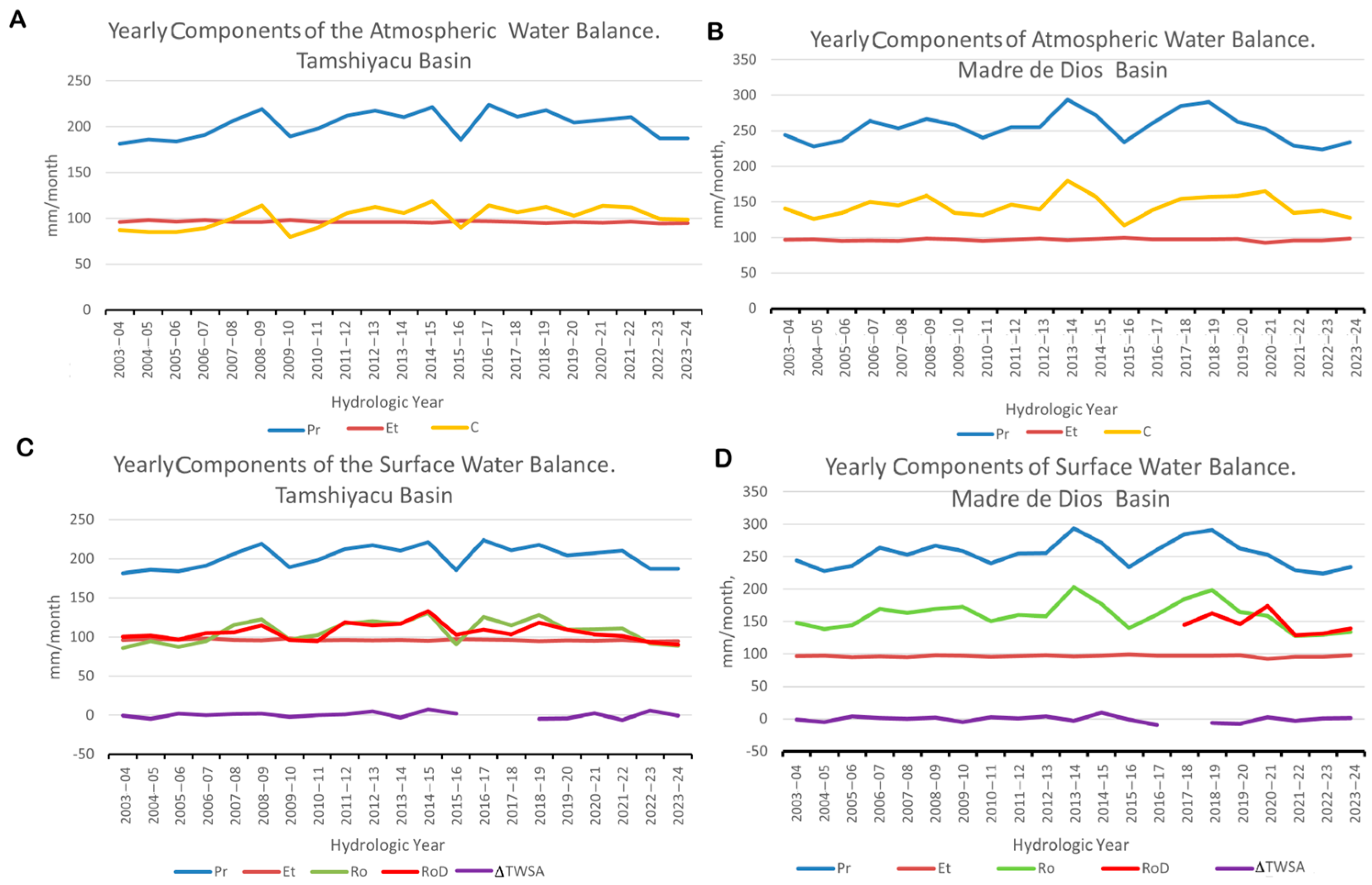

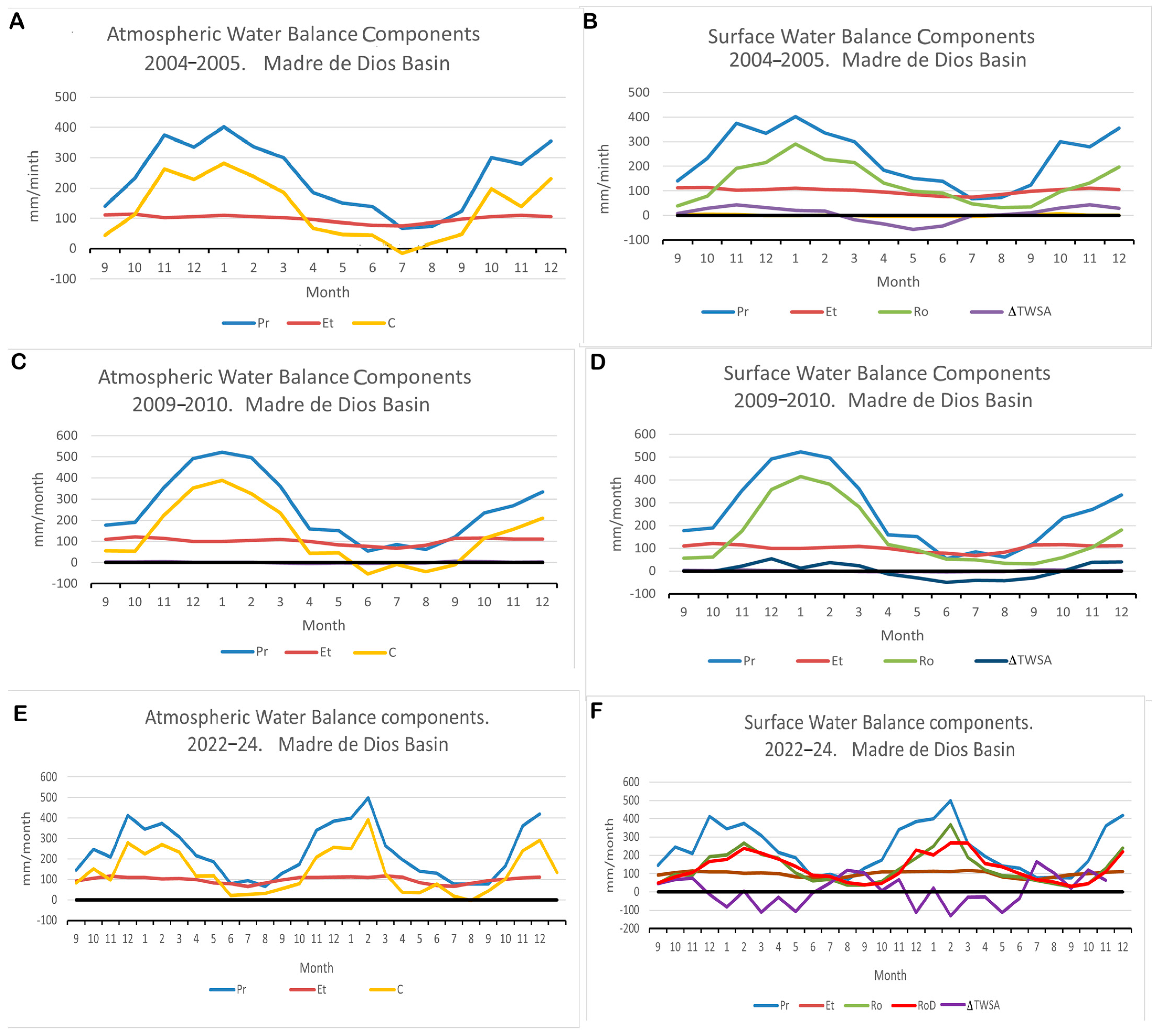
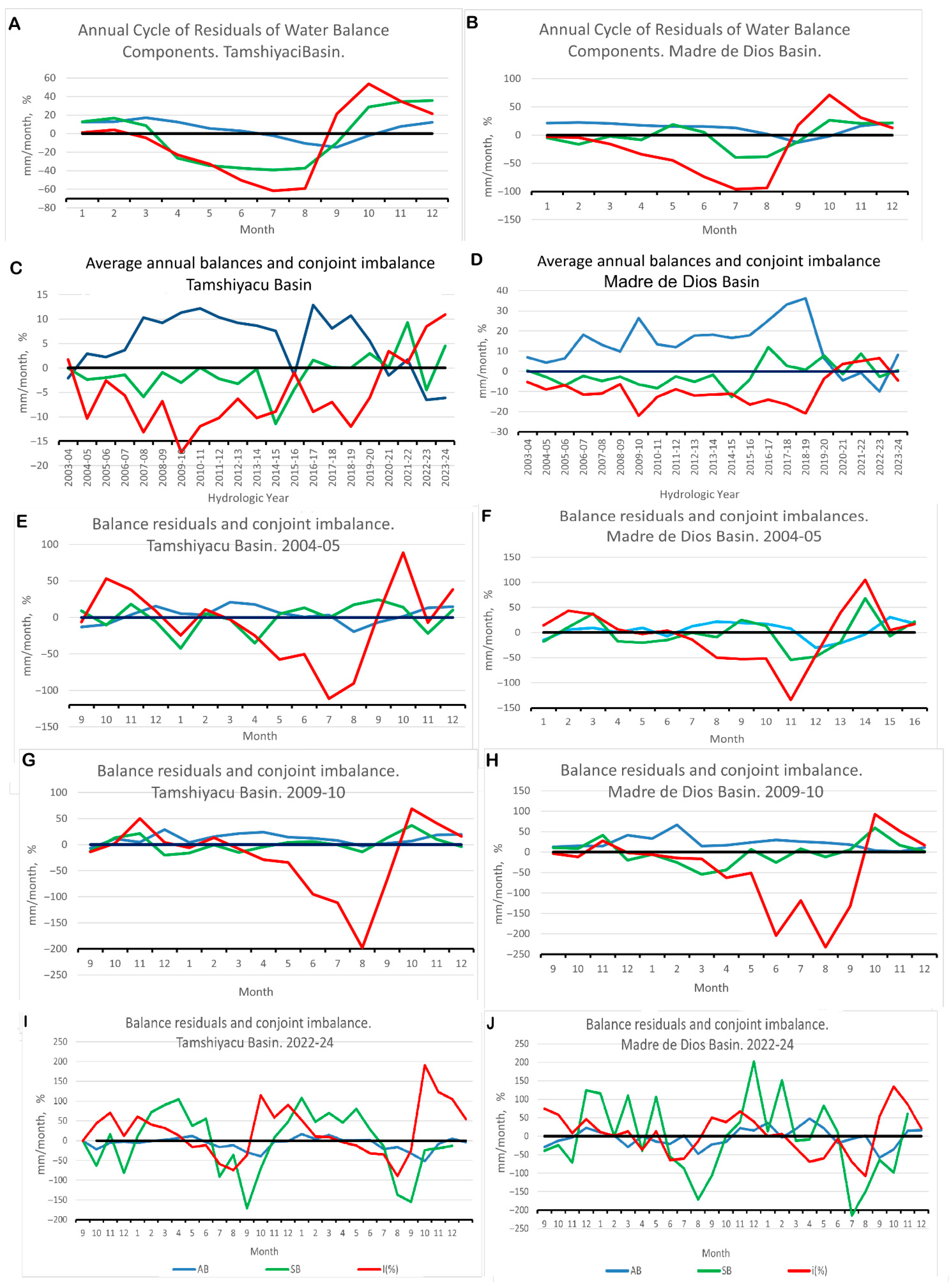
| Bias | Pearson | Kling–Gupta | |
|---|---|---|---|
| Tamshiyacu Basin | |||
| ERA5 vs. Amazon-Paca | 0.06 | 0.379 | 0.376 |
| GLDAS vs. Amazon-Paca | 0.15 | 0.004 | −0.015 |
| Madre de Dios Basin | |||
| ERA5 vs. Amazon-Paca | −0.0563 | 0.395 | 0.392 |
| GLDAS vs. Amazon-Paca | 0.0175 | −0.091 | 0.392 |
| Dataset 1 | Dataset 2 | Statoiistics metrics | ||||
|---|---|---|---|---|---|---|
| Pr | Et | Pr | Et | Pearson | Bias | KGE |
| ERA5 | ERA5 | GLDAS | GLDAS | 0.93 | 0.51 | 0.38 |
| MSWEP | ERA5 | 0.46 | 0.55 | 0.17 | ||
| GLDAS | 0.55 | 0.6 | 0.24 | |||
| CHIRPS | ERA5 | 0.59 | 0.6 | -0.09 | ||
| GLDAS | 0.56 | 0.62 | 0.2 | |||
| GLDAS | GLDAS | MSWEP | ERA5 | 0.41 | 0.09 | 0.4 |
| GLDAS | 0.55 | 0.18 | 0.47 | |||
| CHIRPS | ERA5 | 0.53 | 0.18 | 0.38 | ||
| GLDAS | 0.55 | 0.23 | 0.48 | |||
| MSWEP | ERA5 | CHIRPS | ERA5 | 0.69 | 0.11 | 0.47 |
| GLDAS | 0.75 | 0.15 | 0.69 | |||
| GLDAS | ERA5 | 0.67 | 0.01 | 0.22 | ||
| ERA5 | MSWEP | GLDAS | 0.94 | 0.1 | 0.79 | |
| GLDAS | CHIRPS | GLDAS | 0.82 | 0.06 | 0.76 | |
| CHIRPS | ERA5 | GLDAS | 0.92 | 0.05 | 0.65 | |
| Pr Dataset | Indices | Tamshiyacu Basin | Madre de Dios Basin | ||
|---|---|---|---|---|---|
| Pearson Correlation Coefficient | Level of Significance (>90%) | Pearson Correlation Coefficient | Level of Significance (>90%) | ||
| ERA | MCWD-scPDSI | 0.57 | 99.6% | 0.10 | Non-significant |
| ERA | MCWD-SPEI | 0.63 | 99.9% | 0.50 | 90.0% |
| CHIRPS | MCWD-scPDSI | 0.73 | 99.9% | 0.27 | Non-significant |
| CHIRPS | MCWD-SPEI | 0.67 | 99.9% | 0.08 | Non-significant |
| MSWEP | MCWD-scPDSI | 0.73 | 99.9% | 0.34 | 90.0% |
| MSWEP | MCWD-SPEI | 0.25 | Non-significant | 0.06 | Non-significant |
| Period | Average Pr. mm/mo. | Average Et. mm/mo. | Average C mm/mo. | Average Ro mm/mo. | Average ΔTWSA mm/mo | AB Residual mm/mo. | % of Average Pr | SB Residual mm/mo. | % of Average Pr | I (%) |
|---|---|---|---|---|---|---|---|---|---|---|
| Tamshiyacu | ||||||||||
| 2003–2024 | 202.41 | 96.14 | 101.11 | 94.87 | 0.04 | 5.2 | 1.1 | −1.07 | −0.5 | −5.36 |
| 2004–2005 | 185.95 | 97.96 | 85.05 | 94.87 | −4.53 | 2.93 | 2.4 | −2.36 | −1.3 | −21.35 |
| 2009–2010 | 189.14 | 97.98 | 79.80 | 96.46 | −2.30 | 11.35 | 3.0 | −3.01 | −1.6 | −35.36 |
| 2022–2024 | 187.17 | 94.60 | 98.91 | 90.17 | 2.43 | −6.34 | −0.03 | −0.03 | 0.0 | 8.83 |
| Madre de Dios | ||||||||||
| 2003–2024 | 254.27 | 96.76 | 144.43 | 146.67 | −0.67 | 13.09 | 5.1 | −1.49 | −0.6 | −8.98 |
| 2004–2005 | 227.82 | 97.53 | 125.92 | 138.29 | −0.13 | 4.36 | 1.9 | −7.88 | −3.5 | −20.46 |
| 2009–2010 | 258.51 | 97.48 | 134.62 | 172.58 | −2.30 | 26.41 | 10.2 | −9.26 | −3.6 | −58.01 |
| 2022–2024 | 229.01 | 97.02 | 132.99 | 131.80 | 1.27 | −1.00 | −0.4 | −1.08 | −0.5 | −3.98 |
Disclaimer/Publisher’s Note: The statements, opinions and data contained in all publications are solely those of the individual author(s) and contributor(s) and not of MDPI and/or the editor(s). MDPI and/or the editor(s) disclaim responsibility for any injury to people or property resulting from any ideas, methods, instructions or products referred to in the content. |
© 2025 by the authors. Licensee MDPI, Basel, Switzerland. This article is an open access article distributed under the terms and conditions of the Creative Commons Attribution (CC BY) license (https://creativecommons.org/licenses/by/4.0/).
Share and Cite
Martínez-Castro, D.; Espinoza, J.-C.; Takahashi, K.; Andrade, M.O.; Herrera, D.A.; Centella-Artola, A.; Apaestegui, J.; Armijos, E.; Gutiérrez, R.; Wongchuig, S.; et al. Impact of Extreme Droughts on the Water Balance in the Peruvian–Ecuadorian Amazon Basin (2003–2024). Water 2025, 17, 3041. https://doi.org/10.3390/w17213041
Martínez-Castro D, Espinoza J-C, Takahashi K, Andrade MO, Herrera DA, Centella-Artola A, Apaestegui J, Armijos E, Gutiérrez R, Wongchuig S, et al. Impact of Extreme Droughts on the Water Balance in the Peruvian–Ecuadorian Amazon Basin (2003–2024). Water. 2025; 17(21):3041. https://doi.org/10.3390/w17213041
Chicago/Turabian StyleMartínez-Castro, Daniel, Jhan-Carlo Espinoza, Ken Takahashi, Miguel Octavio Andrade, Dimitris A. Herrera, Abel Centella-Artola, James Apaestegui, Elisa Armijos, Ricardo Gutiérrez, Sly Wongchuig, and et al. 2025. "Impact of Extreme Droughts on the Water Balance in the Peruvian–Ecuadorian Amazon Basin (2003–2024)" Water 17, no. 21: 3041. https://doi.org/10.3390/w17213041
APA StyleMartínez-Castro, D., Espinoza, J.-C., Takahashi, K., Andrade, M. O., Herrera, D. A., Centella-Artola, A., Apaestegui, J., Armijos, E., Gutiérrez, R., Wongchuig, S., & Silva, F. Y. (2025). Impact of Extreme Droughts on the Water Balance in the Peruvian–Ecuadorian Amazon Basin (2003–2024). Water, 17(21), 3041. https://doi.org/10.3390/w17213041







